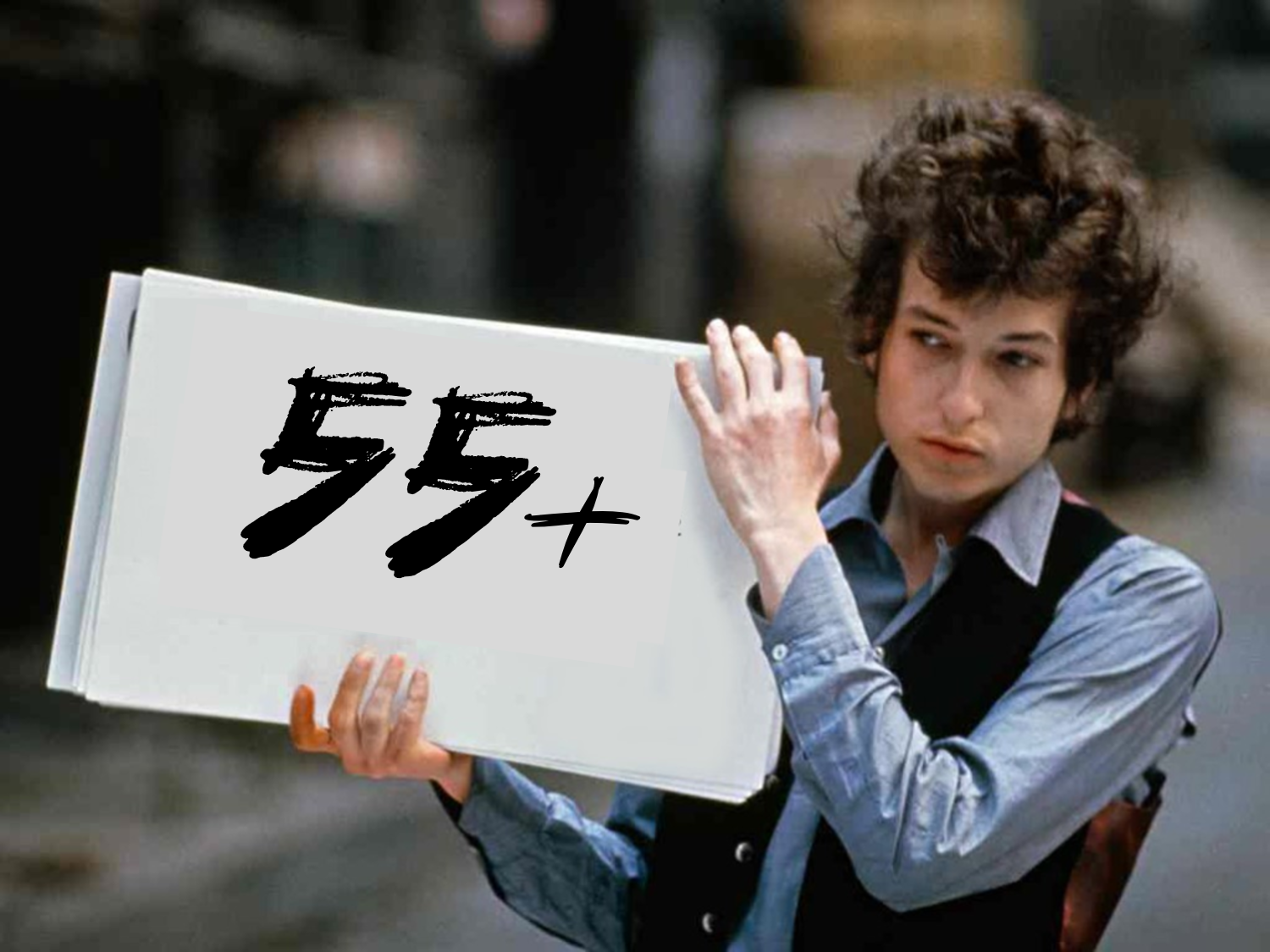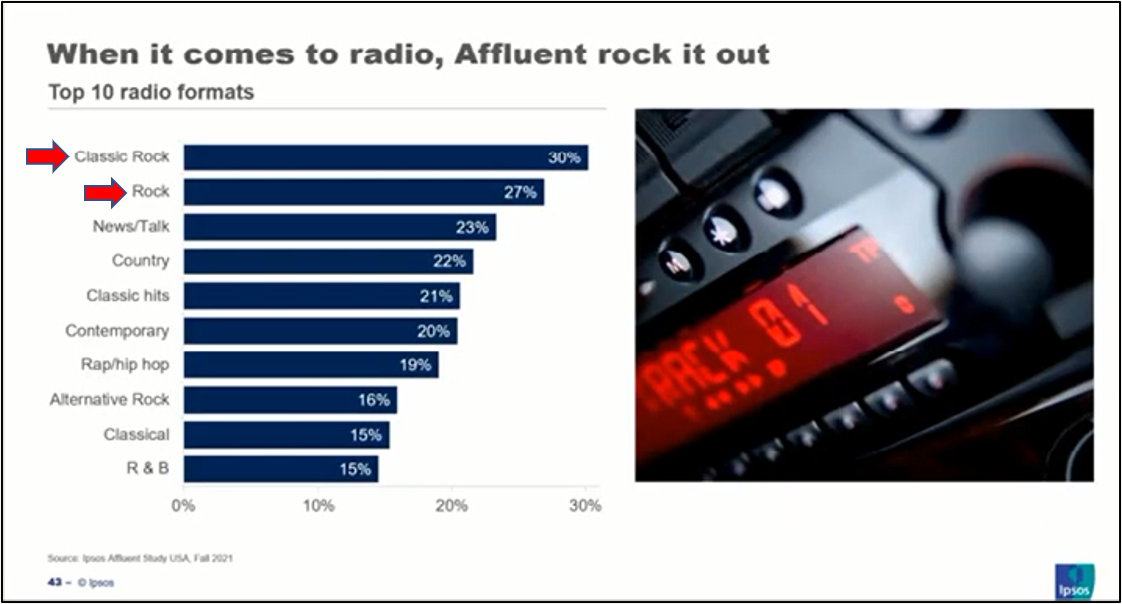
As we know, things tend to fall into 3’s. And that’s the way it has worked for me these past several days.
I’ve bumped into three different stories about the increasing viability of upper-demographic consumers. Coincidence? I think not.
And I continue to wonder why so many other marketers are “getting the memo,” but somehow, radio remains on the outside, fighting or ignoring the trends.
Making things even worse, broadcast radio’s natural skew is to lean older – an apparently intended consequence after decades of targeting adults, at the expense of young people. Now, there’s an emerging avalanche of Gen Z’s, many of whom cannot distinguish a radio from a fax machine.
In a set of circumstances unique to radio, there’s a ceiling on the medium’s efforts to strategically appeal to its naturally older audience. They’re called 55 year-olds, and they represent a hard demographic stop that even the most imaginative marketers simply cannot break through.
So, when I came across this trifecta of great aging demographic stories – all revolving around highly respected sources – it seemed like just the time to bang my head against the granite walls of radio’s demographic cliff once again, and tell you about them. And maybe, just maybe, you’ll share this post with your friends in the ad industry who often work against their best instincts – and logic – to eschew aging demos most likely to buy stuff – lots of stuff – in this increasingly unpredictable economy.
1. Classic Rock = Affluence. That’s the gist of an Inside Radio story that ran yesterday. A new Ipsos study, “Media Still Matters: Affluent Deep Connection With Media Brands,” points to the radio formats most flush with the affluent.
Ipsos presented a recent webinar that drove home the fact that the more you rock, the more income you make. The favorite radio formats of the affluent (household income of at least $125,000 per year) fall in this order. The percentage represents how many affluents consider each format to be a key choice:

I don’t have to tell you the demographics of Classic Rock. Now that Oldies, Jazz, Soft AC, and Classical have been vanquished from the FM radio dial, radio stations that specialize in AC/DC, Led Zeppelin, Aerosmith, and Queen represent a lot of listeners who have fallen out of ad agency favor while still paradoxically being some of the most affluent citizens in the U.S.
Darrin Stevens and Don Draper knew better. You set your sights on the audience demographic with the most money. It’s counter-intuitive to draw the line at 55 when the wealth skews older. It hurts radio and it hurts their clients who could be reaching those with more buying power.
 And here’s some anecdotal proof, royal-style. It turns out Prince William is a self-admitted rock dog. (Or is it a corgi?)
And here’s some anecdotal proof, royal-style. It turns out Prince William is a self-admitted rock dog. (Or is it a corgi?)
Last I checked, he clearly fits the “affluent” category. Heavy Consequence via Blabbermouth reports the 39 year-old gets psyched up for royal events by cranking AC/DC:
“There’s nothing better than, on a Monday morning, when you’re a bit bleary-eyed after the weekend and trying to get yourself back into the grind of the week, listening to AC/DC, ‘Thunderstruck,’”
Strange…I thought it would be “Moneytalks.”
2. Is the 55+ demographic “on the verge?” That’s the opinion of Phil Rowley (pictured), Head of Futures at Omnicom Media Group, UK. In a recent story in AdWeek – “Marketers Should Prepare for the Great Demographic Disruption” – Rowley made this bold prediction about what’s around the marketing corner:
Marketing will focus less on young people
And he questioned why demographic groupings usually fall into 10-year cells (except 18-24), while marketers use 55+ as a catch-all for mature consumers. Rowley believes assuming that all mature listeners are the same is naiive and wrong-headed. And as he opines, “This won’t cut it in the future.”
consumers. Rowley believes assuming that all mature listeners are the same is naiive and wrong-headed. And as he opines, “This won’t cut it in the future.”
I caught up with him last week, and he was kind enough to answer my question about demographics, marketing, and where we may be headed:
Fred Jacobs: Let’s start with your idea that “marketing will focus less on young people.” Agencies have always been focused on glamorizing youth, and making older people aspire to be younger. Are you seeing tangible signs from advertisers and agencies that there’s opportunity for an older demographic to become more viable and central?
Phil Rowley: Not really. Whilst there are brands who target older demos naturally, like some car brands e.g Porsche, more conservative media outlets like The Daily Telegraph, and of course products designed specifically for the older gen, I’m not sure I see much consideration given to older demos as a growth area.
And that idea of a growth area is most important, because I think in the future, brands with product portfolios would do well to think about how a burgeoning older generation could be brought into their category, though previously excluded. I wrote the article in part to highlight that point.
FJ: The idea of focusing on demographic groups above 54 is intriguing. So, 55-64 and 65-74 make sense. Are you thinking 75+ or even carrying it a bit older to better understand the nuances of generational segments even older?
 PR: I think the degree to which older audiences need to be segmented as we see more gradations and subtleties between age-bands, will increase proportional to extensions in lifespan. Right now, I don’t think there’s much difference between targeting an 80 year-old and a 90 year-old. But in 25 years, there may well be.
PR: I think the degree to which older audiences need to be segmented as we see more gradations and subtleties between age-bands, will increase proportional to extensions in lifespan. Right now, I don’t think there’s much difference between targeting an 80 year-old and a 90 year-old. But in 25 years, there may well be.
In the future, we may see campaigns that are targeted at 70-75 year-olds, but not 75-80 year-olds. We’re not there yet, but we may soon will be.
FJ: You mention that older citizens are dictating policy (ex: Brexit). In the States, you could say the same thing about senior voting – always more reliable. Can you elaborate on your thought this will become more pronounced as the older generation grows?
PR: This is slight conjecture on my part, but I have seen no evidence for older cohorts abandoning their priors as they move into old age. Thus, the longer the autumn of life, and the more people there are living through that autumn, the more likely they are to shape public discourse. However, there is an important caveat.
There’s some interesting work done by Steven Pinker in his book “Enlightenment Now,” which highlights a key insight with regard to aging and politics. Namely, that people don’t get more conservative as they get older. They simply keep hold the opinions gained in their formative years, which was the prevailing orthodoxy of the time, and is only conservative by today’s standards.
If people reversed their more liberal opinions in old age, we would also reverse the progress we’ve made on important issues like equal rights. Thus, today’s 30 and 40 year-olds are not about to shift (to the) right as they hit 50 and 60 and 70. But….at any one time, the bigger the older cohort is, the more likely they are to exert disproportionate influence at that moment.
FJ: You contend the demographic shift “is likely to be one of the most profound disruptions in centuries.” How should we be thinking about researching mature consumers – their attitudes, buying patterns, political leanings, etc.?
researching mature consumers – their attitudes, buying patterns, political leanings, etc.?
PR: I’m not sure it matters how you research them, just as long as you do. I think it’s incumbent upon us to update our view of older generations, and actually understanding their journey through the second half of their life.
What may be an interesting angle for insight is, rather like we have a very clear cultural view of pre-50s journey [eg. Teens = education & leisure // 20s-30s = career & relationships // 30s and 40s = family & career], we should build an understanding of how priorities change as the decades stack up, post-50. We should be researching the differences between gradations as life progresses.
FJ: You suggest in the article that marketing strategies may focus less on modern technologies (mobile, Alexa, Clubhouse) but on “using existing and well-loved channels with great efficiency,” while including older people in ad campaigns. Can you comment on the efficacy of traditional marketing channels (radio, TV, print) for reaching mature consumers? Are they still viable or is the future a more hybrid approach that combines legacy media with new media platforms?
PR: I would say broadly that linear TV and linear radio are patronized by older generations – and indeed print. Perhaps more so than younger generations. But as we increasingly become a digitized society, and generations of people like myself who learned to use the internet in the early 90s grow older themselves, and as there is increasing convergence between technologies and media forms, your question will become more difficult to answer.
generations. But as we increasingly become a digitized society, and generations of people like myself who learned to use the internet in the early 90s grow older themselves, and as there is increasing convergence between technologies and media forms, your question will become more difficult to answer.
FJ: How much of the current bias against older demographics exists because of most media buyers and planners being in their 20s and 30s?
PR: This has been a bias traditionally. As I mentioned, advertisers have used youth as the aspirational structure for their campaigns, and by extension the industry has always sought to employ people young enough to understand the audience of tomorrow.
However, I think the last 5 years has seen agencies come alive to their responsibilities from a Diversity and Inclusion perspective. Naturally, this initially focused on race, gender, LGBTQ and neuro-diversity, but I think age is becoming an equally prominent consideration within those workstreams.
Thus, given we have a growing cohort of older audiences, and within the industry we will always have people reaching a level of maturity which previously may have been considered ‘past it.’ I hope to see some movement in our biases here as we attempt to decode older audiences using veterans of the industry who are themselves now part of that cohort.
FJ: What advice would you give to those in media trying to affect change at the agency level? What’s the best way to change hearts & minds on this issue?
PR: To build on the above, I think age needs to be positioned/aligned with Diversity and Inclusion workstreams to ensure we are not automatically ridding ourselves of experienced workers who still have much to give, and can still give you insight into a demo that seems to be growing, yet seems to be painted in broad brush strokes.
3. Here come those crazy septuagenarians – Now that you’re wrapping your head around the concept of a 55-64 demographic becoming viable, in walks Mark Bradbury, AARP Media Solutions senior director of insights and marketing.
in walks Mark Bradbury, AARP Media Solutions senior director of insights and marketing.
Now, you might dismiss him based on his employer, but Bradbury makes a compelling case for the “over-70 demo” in a recent MediaPost story by Todd Wasserman.
Bradbury points out there are already 40 million adults in the U.S. that have cracked “the big 7-0,” and their growth over the next decade is estimated at more than 15 million – twice as robust as the 18-49 year-old demo.
These oldsters are already responsible for more than a trillion dollars of spending on consumer goods and services. Key categories include pharma, health insurance medical supplies, AV equipment, food, personal care, entertain, furniture, and car insurance.
Bradbury maintains their DNA has always been about “promise and possibility.” These Boomers have a feeling of empowerment to continue to live their best lives,” thanks to advancement in medicine and health.”
At a time when radio broadcasters need to expand advertising categories and demographic opportunities, more and more branding experts, marketers, and futurists are logically looking the senior sector of the economy.
For radio, of course, this dovetails perfectly to its sweet spot – consumers who have happily been listeners their entire lives.
- What’s Fair Is Fair - April 1, 2025
- What’s On Your Bucket List? - March 31, 2025
- “Honey, would you please talk to Alexa?” - March 28, 2025




It’s odd to me that an industry so deeply reliant on data, trends and demography is blind to what’s happening right in front of them.
Crazy, right? The facts speak for themselves. Why the ad agencies continue to fall into protocols that made sense in 1986 when everything else has evolved is more than just curious. It’s absurd.
This oldies programmer says…don’t get me started on this.
I know, I know. If I ruined your morning, I apologize. Have another scone, Kevin.
Rowley cites Pinker for something I’ve long thought should have become obvious by now: Ageing people do not “become [politically] conservative” (or start talking funny), they just continue as they are while the folks coming up after them reflect their own viewpoints (“liberal” or whatever) (and talk a different lingo)–which provides yet further evidence that “liberal” and “conservative” are meaningless adjectives. Exhibit 1: Noam Chomsky, whose birthday is today, is a “liberal” by anyone’s gauge, but all he has done is conserve the point of view he’s had for decades; so he’s also a conservative. The labels are not constructive.
I may be part of the new 65-74 demo, Fred, but like you I’ll continue to be iconoclastic. And listen to radio. “Same as it ever was.”
As labels go, John, I’ll take iconoclastic any day of the week. Thanks for another fine addition to the “comments” section.
Talk about an “oldie but goodie” topic, Fred! Thanks for the fresh insights. Of course, you’re preaching to the choir, at least where I’m concerned: a 66-year-old guy who’s ready, willing, and able to spend his kids’ inheritance.
Exactly! And something tells me you and Heather are spending as much, if not more, than you were when you were in your 30’s. Thanks for the comment.
Client:
I’d like to hire your agency to get customers for my business.
Agency:
We will put you on the #1 station with 25-54 Adults.
And we’ll make them do a value-added promotion.
Client:
Uh, well OK. You’re the experts
That’s the mindset we have to change. It has been outdated for many years now, but the longer it persists the more danger radio is in financially. Right on the mark, Marty.
Wash, rinse, repeat. That’s the mantra, Marty, and few seem to question it.
I am a card carrying member of the Baby Boom generation who retired last year. Before moving from the radio business to television, I spent 10 years wearing headphones 5 hours a day, six days a week playing rock & roll LOUD. Two weeks ago, in a spin class, I requested that the music be turned down a tad. To which a young 25-34 year old woman responded, “well, you know what they say. Too loud, too old.” Insert what I wanted to say here _______ ___.
This topic always frustrates me. Despite piles upon piles of great research demonstrating the POWER of the Baby Boom generation, agencies continue to poo-poo the notion of any demos beyond 18-34, 18-49 and 25-54. And this gets jammed down the throats of media buyers who take it as gospel for the remainder of their careers.
Here is another recent piece on the “older” generation:
https://www.adweek.com/brand-marketing/infographic-its-time-to-rethink-baby-boomers/
Both the radio and television businesses need to band together to tackle this issue head-on. Anyone from the NAB, RAB or TVB listening?
David, I enjoyed the spin class story. I think it speaks for a lot of us.
Thanks for the AdWeek story, and I echo your advice the industry needs to speak in one voice to advertisers and agencies about rethinking spending power, demographics, and tired conventional wisdom.
I’m late to the party here but this column led me to two thoughts.
1) If the “peace/love/suppose they gave a war and nobody came” generation was always really “America first”, was all of their proclaimed liberalism just a shroud for sex drugs and rock and roll? On the surface, there seems to be a disconnect between what people said and did then and what they do now.
2) Boomers attaching age to the the race/LGBTQ/gender equality movement is a fascinating idea, because the boomers are, as a group, quite uncomfortable with most of that group. have a discussion with some boomers about pronouns and then ask yourself whether this is an alliance with real possibilities. Boomers invented age discrimination and it will be interesting to see just how much of what they abhor they’re willing to stomach to get that one last job or seat at a restaurant power table.
Certainly, not everyone was a hippie protesting in 1968. And Boomers have proven to be a large group, but certainly not an altruistic one. Always appreciate hearing from you.
Writing this after watching “The Pen” episode of Seinfeld.
Sure, the alte kakers got the gelt, but who’s gonna get it when we take our dirt nap in ten to fifteen years? (We should live so long.) Seems advertisers are targeting our inheritances by targeting our kids.
Are the Progressive “Becoming your parents” commercials funny or flip-offs to upper demos? I’m guessing they ‘test’ funny because upper demos don’t see themselves as being old… even though our adult kids and grandkids do.
Frankly, I’d rather have that last marble rye. Many thanks, Jim.
Great post,, and comments here!!
I program 10 “gold” stations on internet streamer GotRadio.com. Our top 3 stations are hip hop-Top 40 & Urban.
Our 60s station is the 4th most popular(out of 40 stations), followed by Soft Rock and Classic Rock.
There’s an audience for those oldies, & classics Fred.
And a BIG one.
65+ folks are streaming, because their music’s gone from terrestrial radio.
I’m still stymied by the way broadcast execs think. We can only hope the times they are a changing.
Again.
Mature adults…OK, AARP members…also had to learn how to stream on multiple devices during COVID when they released they did not have a radio nearby. Thanks for the reminder, J.C.
It continues to amaze me that when I attend concerts there is always a high proportion of fellow “boomers” around me, and yet music radio provision for us lot is mostly dumbed down “Cinderella music”. That is a very new term for what gets played at us over the radio (copyright me under 1 min ago). When the clock struck midnight on 31st December 1989, we all had to suddenly, dramatically, leave the Ball of music and (we’re told) suddenly started hating new music. 30 years of music made which is not for the likes of us, apparently, is complete rubbish, apparently. We want (we’re told) to have radio sounding like it did in 1989 or earlier, often with the same DJs and with their same “put-on” voices as 1989 or earlier. We’re told.
Apparently, we now mostly like the music our parents liked at our age – “easy listening”, “crooners”, nothing too noisy, too “heavy”. But I’m wondering what happened to the Woodstock generation – protestors for peace and love in the 1960s, the prog rock fans of the 1970s, the punks of the late 1970s, the heavy metal fans of the 1980s,the dance and rap fans of the 1990s, the reggae fans, the rock fans. Those who still attend concerts, those who can afford to, who go to Glastonbury. We call many of them boomers, but radio is not catering for them.
Being a 60 year old, a 70 year old, an 80 year old, in 2021 is very different from what it used to mean. We’re a relatively wealthier, healthier lot, working later in life, we have spent more of our income over our lives on music than any other generation ever. And many still do. Generally, we’ve not stopped loving music, its truly in our DNA, yet radio has largely abandoned us, not focussed on our spending power, on any depth of music styles. Radio, you could try harder, much harder, and make money in doing so.
Thanks Fred, as ever, for another great piece.
I love “Cinderella music” (or “radio”), Ian. You might want to scoop that up in the UK. I’d be happy to rep you here in the States.
Seriously, you’ve hit on an important distinction. The older generation today is a lot different than in those “Mad Men” days. And the data clearly shows spending power and the willingness to buy stuff – LOTS of stuff. Every time broadcast radio throws in the towel on a format, SiriusXM picks up the baton and offers multiple versions of the abandoned genre. Radio broadcasters in the U.S. at least should have figured this out by now.
Thanks for a stimulating comment.
Radio station executives look at this question from a very narrow point of view…the view from the radio station. “Agencies don’t like my old demos.”
In fact, advertising agencies are well aware of the value of 55+, but why should the media plan make a point of “buying” the 55+ demo when the it comes free with any 25-54, or 18-49 buy an agency makes?
Radio is a small fraction of ad spend. The big money is in video (TV, cable, sat, streaming, pre-rolls, CTV, mobile, etc.) and the audience delivered is awash in 55+ viewers.
Thanks for the perspective Barry. I thin media buyers are also in the business of diminishing radio’s strengths to negotiate a better rate. The fact radio doesn’t pitch all the pharma, health care, and other categories all over TV is so off kilter. And of course, 55+ is a prime radio listening demo. Thank you for the comment.